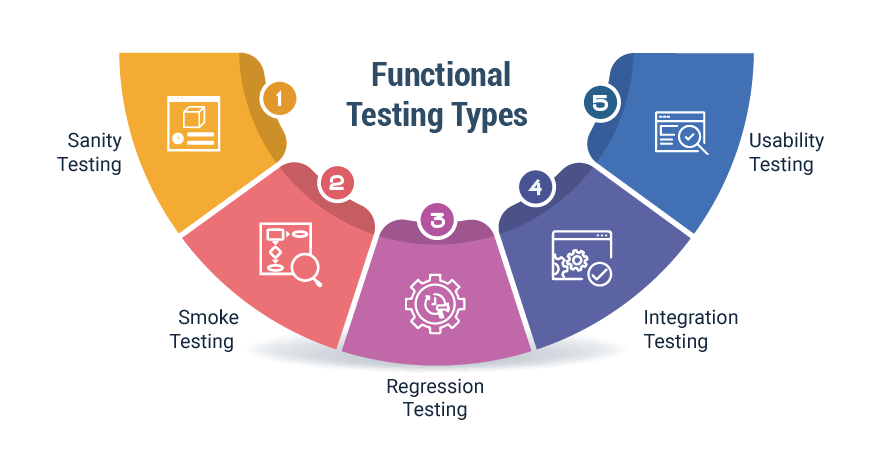Modern-day enterprises are always under pressure to deliver top-notch products at speed. But the risk of releasing any web application without proper quality assurance can have major implications now than ever before! This is where functional testing can help to analyze the quality, reliability, and performance of the web application to ensure it works as intended.
For businesses looking to leverage functional testing services for faster software releases, this blog would offer detailed insights into how it’s done effectively, industry best practices, Rishabh’s approach & more.
What is Functional Testing?
It is a type of black-box testing that’s imperative to enhancing software quality. This method deals with the validation of the functional requirements of the business application, verifying whether the software is working as per customer needs. It is not concerned with how processing occurs, but rather, with what should be the focus of processing results.
Software functional testing validates all the requirements of an app to ensure it has a lucid user interface, a coherent API, seamless integrations with key business systems & works exactly as per end-user needs. It answers fundamental questions like:
- Is the software easy to access & navigate?
- Is it easy to switch between open apps?
- What happens in case of an error?
- Is the payment gateway reliable?
So, then what’s the difference between functional & non-functional testing? Let’s find out.
Functional vs Non-Functional Testing
Here are essential differences between the two types of testing methodologies,
| Functional Testing | Non-functional Testing |
| Checks the operations and actions of an Application. | Checks the behavior of an Application. |
| Conducted based on business requirement | Conducted based on the customer expectation and performance requirement. |
| Tests – actual vs expected result output | Checks the response time, and speed of the software under specific conditions. |
| Carried out manually | More feasible to test using automated tools. |
| Types: – Unit testing – Integration testing – System Testing – Acceptance Testing |
Types: – Performance testing – Load Testing – Stress testing – Volume testing – Security testing – Installation testing – Recovery testing |
Types of Functional Testing
The 5 most prominent and widely used types are:

1. Sanity Testing
Performed when testers don’t have adequate time to test. This surface-level test enables the QA engineer to verify that all the commands, functions & menus built into the product are always working optimally.
2. Smoke Testing
Typically performed after the product is developed to assess if the critical features of the program are functioning well. It is executed before any regression or functional tests are conducted on the software build. The goal is to reject a badly broken app for the QA team to save time on installing and testing the product.
3. Regression Testing
It involves re-execution of test cases to ensure that the previous functionality is working fine, and new modifications have not invited any bugs. This test can be conducted on a newly built program or code snippet where there is a remarkable change in the original functionality.
4. Integration Testing
Ideally performed after unit testing is done, it verifies proper functionality between surrounding components, thereby eliminating the need to retest every combination with low-level functionality.
5. Usability Testing
It ensures the product meets user needs. Functionality testing precedes the beta test to ensure valid feedback from the testers using the app. It is the last step before any feature goes live.
Functional testing is essential and when it is rightly executed, it helps reduce the number of software bugs, thereby improving the end-user experience.
Functional Testing Techniques
Based on the scenario, different functional testing techniques are used to ensure enhanced code quality, optimized performance, and continuous delivery. These techniques help improve the frequency of new product releases while facilitating consistent feedback & improvements across the STLC. They can be classified into the following two categories:
1. Positive Testing
This testing type validates that the software meets the bare minimum requirements of the end-user and functions optimally. It can be further subdivided into three different categories:
- End-user based test
- Alternate path tests
- Decision-based tests
2. Negative Testing
This type of testing checks if the app behaves as expected even when it is subjected to constant changes in source code or an unexpected data surge. It can also be classified into three sub-categories that include:
- Boundary value tests
- Equivalence tests
- Ad-hoc tests
In this era of ever-changing user expectations, a lot of value revolves around developing & testing frequently to enable incremental change and accelerate time to market. Our rich experience in DevOps testing and implementation empowers our clients to foster an agile environment of Continuous Integration & Continuous Testing. We can help you integrate automated software testing with your deployment and operations.
Functional Testing Processes
The complete overview of a functional test includes the following 3 stages:
1. Creation of input values
2. Execution of test cases
3. Comparison of the actual and expected outcome
And, the above stages can be segregated further into sub-steps as listed below;
- Define the functionality that is to be tested – product usability, error conditions, messages, or main functions
- Create input data for all the functionalities that are to be tested as per specific requirements
- Determine all the permissible output parameters
- Execute test cases
- Compare the output against the predefined output values to validate that the system is behaving as desired.
Functional Testing Use Cases
Use Case 1:
REST API Testing for an enterprise mobile application of a prominent technology solutions firm
A 20-year-old technology solutions firm wanted to automate Rest web services using SoapUI for their mobile & web services
Challenges:
- An ever-increasing volume of regression testing
- Complex test scenarios
- No right tools for testing
- No proper documentation to understand app functionality
Rishabh Software’s QA & Testing team integrated live automation scripts with Jenkins. HTML test reports were also generated after the automation solution was implemented.
Business Benefits:
- 100% Functional Test coverage
- Reduced testing time & efforts for regression cycles
- Test execution of web services in a cloud environment
Use Case 2:
Mobile and web services automation testing for a leading outdoor advertising brand
A leading outdoor advertising brand wanted to improve test coverage, accuracy and achieve cost-efficiency for its enterprise product.
Challenges:
- Heavy script maintenance
- Poor response times
- Manual testing
- Lack of automation
Our testing team implemented a hybrid testing framework using selenium and implemented automated testing for their web and mobile services
Business Benefits:
- 800+ Test cases executed in minutes
- Parallel testing on cloud
- Improved test result and reporting mechanism
- Improved Quality of Service (QoS)
Functional Testing Tools We Employ
Quality at Speed is what matters in today’s dynamic digital world and the right set of tools are the key to achieving it! Let’s take a look at the top three tools that we leverage along with their key features.
Selenium
Widely popular and preferred automation testing tool helps avoid manual work, accelerates feedback, and saves significant time spent on running repeated tests. It ensures consistency with the same preconditions & expectations.
Key Features:
- Multi-browser support
- Multi-platform support
- Ideal for cross-browser testing
- Suitable for testing mobile web apps using Apple & Android drivers
- Multiple programming language support
- Covers all types of functional testing
Unified Functional Testing (UFT)
Useful for performing regression tests. It is best suited for first-time testing of new apps as it requires the least effort to create a UFT script. Further, it helps centralize functional testing across enterprise architectures and streamlines automated and manual testing.
Key Features:
- A tech stack that supports 200+ environments & apps
- Runs on all main browsers
- Fast and secure installation process
- GUI, API & business process testing on one common UI
- Built-in object repository
- Smart object detection & correction
- Image-based object recognition
Soap UI
Designed to accelerate the delivery of RESTful & SOAP APIs, this open-source testing tool is the best option for web service testing. It makes load testing fast and easy with record tests that can be reused. We use it to perform functional tests, performance tests, regression tests, interoperability tests and much more.
Key Features:
- User-Friendly GUI
- Automation with Groovy
- Script-less functional testing
- Security & load testing
- API Mocking
- Protocol Support
- Vibrant community ecosystem
What Makes us a Trusted Functional Testing Company
The advancements in the field of technology are enabling companies to bring in new products to life. For them to successfully work as a high-quality, efficient and functional product, in-depth testing is a must. A combination of functional and non-functional testing can help achieve this goal. We at Rishabh help facilitate the whole testing process to create and analyze test cases with modern technologies.
As an experienced software testing and QA company, we leverage our proven framework with the right mix of automation tools and testing methodologies to ensure a superior user experience and functional completeness. With us, you can be rest assured that the final product will behave as expected!











 30 Min
30 Min


